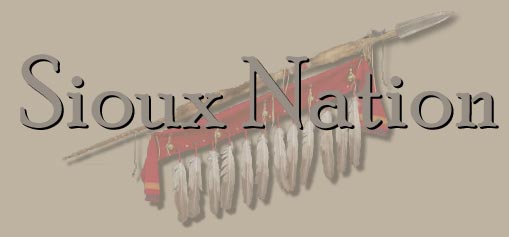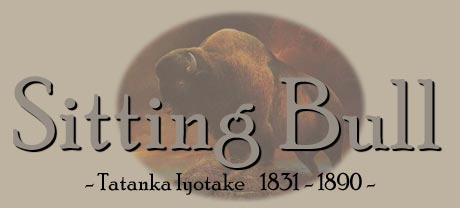 |
|
The name Sioux derives from the Chippeway word "Nadowessioux" which means "Snake" or "Enemy". The Sioux were a proud people with a rich heritage. They were the masters of the North American plains and prairies, feared by other tribes from the great lakes to the rockies. With an aboriginal population of more than 30,000 people in seven different tribes throughout the great plaines, the Sioux Nation were one of the largest tribes in the western hemisphers. The Sioux were
a deeply spiritual people who communed with the spirit world through
music and dance. Two of the most religious cermonies of the Siox were
the Ghostdance and the Sundance. During the Ghostdance, participants
worked themselves into a frenzy and could envision a future of Indian
supremacy. In the Sundance a medicine man slits a man´s chest
and slides a skewer through the flesh, then blowing an eagle-bone whistle
and tethered to a central pole, the dancer begins tugging until the
skewer is torn away. The torment fullfills a dancers sacred vowes, by
dancing and enduring the pain of the self-inflicted wounds, each participant
reasserted his identity as an Indian warrior. |
 |
| Sitting
Bull - Tatanka Iyotake, Born about 1831 near Grand River, in present day
South Dakota. Belonging to the Hunkapapa group of Lakota people, the most
northern of the Tentonsious´s seven tribes. Despite that his youthname
was "Hunkesni" - Slow - he proved in early years an unusual
go-ahead spirit, and would soon distinguish him self in the constant dispute
between other tribes. He was only 14 years old when he had his first real
war achievement, in a raid on the Crow. His total lack of fear was soon
to wide renowned. About 1856 Sitting Bull became a leader of The Strong
Heart warrior Society. He was also known as a religious and cultural leader
as well as a composer of songs. Sitting Bull´s followers strongly
believed that it was his strong medicine that brought them all this fortune
of war. Sitting Bull himself also believed that his power came from the
serious and deep contacts he had with all the mystic powers and supreme
being of the Universe.
Widely respected
for his bravery and insight, Sitting Bull became head chief of the Lakota
Nation around 1868. Sitting Bull was and remained a sworn enemy to the
whites, which wasen´t beacuse of any personal expirience, it was
more because of his consistent attitude to the traditional Indian standard
of living. He considered that any approach to the whites would implacable
break down the Indian culture. His apprehension fortified in his belief
when he saw the fast outgoing morality that was occuring in the tracks
of the whites, where diseases, alcoholism were spreading like wildfire
in the Indian villages. After the battle of Rosenbud on June 17, where Crazy Horse faught the American soldiers, the Lakota moved their camp to the valley of Little Big Horn, to celibrate their victory over the white soldiers. They were soon joined by more than 3000 other Indians who had left their reservations to follow Sitting Bull. And here. on June 25th, they were attacked by the 7th U.S Cavalry regement led by George Armstrong Custer. The U.S cavalry were outnumbered and after the battle all of the 7th U.S cavalry had been killed. Among them George. A´. Custer.
|
|
|
|
GUESTBOOK |
|
Webdesign by Black Hawk Designs © 2003
by The JavaScript Source
Midi music "FLUTE OF PEACE" by Unknown |


 bravenet.com
bravenet.com